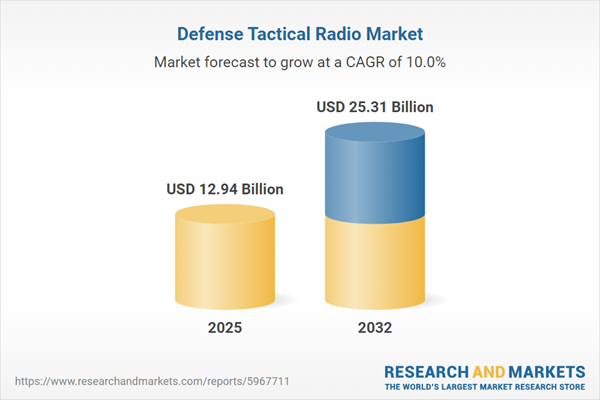Speak directly to the analyst to clarify any post sales queries you may have.
The Defense Tactical Radio Market is evolving rapidly as military organizations worldwide embrace advanced communications solutions designed for modern, network-centric operations. This analysis presents a focused overview for senior leaders seeking to inform strategic procurement and investment decisions amid shifting technological, regulatory, and geopolitical landscapes.
Market Snapshot: Defense Tactical Radio Market Growth and Outlook
The Defense Tactical Radio Market grew from USD 11.83 billion in 2024 to USD 12.94 billion in 2025. It is expected to continue growing at a CAGR of 9.97%, reaching USD 25.31 billion by 2032. These figures illustrate persistent demand growth driven by rising defense budgets, cross-border tensions, and sustained modernization initiatives in key regions, confirming the sector’s ongoing momentum.
Scope & Segmentation of the Market
- Device Types: Combat Net Radio, Handheld Radio, Manpack Radio, Vehicle-mounted Radio
- Frequency Ranges: High Frequency (3-30 MHz), Ultra High Frequency (300 MHz-3 GHz), Very High Frequency (30-300 MHz)
- Technology Types: Analog Radio, Digital Radio
- Modes of Operation: Multichannel, Single-Channel
- Platform Types: Airborne, Ground-Based, Naval-Based
- End Users: Air Force, Army, Border Security, Navy, Police / Law Enforcement
- Regions Covered: Americas (North America: United States, Canada, Mexico; Latin America: Brazil, Argentina, Chile, Colombia, Peru), Europe, Middle East & Africa (Europe: United Kingdom, Germany, France, Russia, Italy, Spain, Netherlands, Sweden, Poland, Switzerland; Middle East: United Arab Emirates, Saudi Arabia, Qatar, Turkey, Israel; Africa: South Africa, Nigeria, Egypt, Kenya), Asia-Pacific (China, India, Japan, Australia, South Korea, Indonesia, Thailand, Malaysia, Singapore, Taiwan)
- Major Companies Profiled: Thales Group, L3Harris Technologies, BAE Systems, BK Technologies, COMSYSTEMS LLC, Domo Tactical Communications, Elbit Systems, General Dynamics, Hytera Communications, ICOM Inc, Leonardo S.P.A., Motorola Solutions, Northrop Grumman, Patton Electronics, Radmor, Rohde & Schwarz, Rolta India, RTX Corporation, Savox Communications, Silynx Communications, Thuraya Telecommunications, Triad RF Systems, AeroVironment, ASELSAN, Creomagic, EF Johnson Technologies
Key Takeaways for Senior Decision-Makers
- Integrated software-defined radio platforms are setting new standards in interoperability and network agility, critical for supporting joint-force and multi-domain operations.
- Defense organizations prioritize modularity and upgradeability, allowing rapid adaptation to emerging threats, waveform updates, or new cybersecurity requirements with minimal hardware changes.
- Artificial intelligence and machine learning are increasingly embedded in radio systems, enhancing real-time threat detection, interference management, and spectrum allocation during complex operations.
- Strategic procurement now places emphasis on open architecture and supplier diversification to counter supply chain vulnerabilities, reduce costs, and mitigate exposure to regulatory or geopolitical shifts.
- Regional adoption trends are influenced by alliance interoperability needs, ongoing modernization to comply with evolving military standards, and the unique environmental or operational challenges of each geography.
Impact of United States Tariff Adjustments
- Recent tariff measures have increased manufacturing complexity and shifted sourcing to diversify suppliers, especially for semiconductors and RF modules.
- Procurement cycles focus on resilience, inventory management, and risk mitigation, prompting defense organizations to reinforce partnerships and consider nearshore production.
- Lifecycle planning now extends beyond upfront acquisition, with more scrutiny of long-term costs and the sustainability of selected technologies and supply contracts.
Methodology & Data Sources
This market report utilizes a multi-phase methodology, combining primary research—such as interviews with defense procurement officers, communication specialists, and integrators—with secondary research from procurement documents, regulatory filings, and technical literature. Findings are validated and cross-checked using data triangulation and scenario analysis to ensure a robust and actionable perspective.
Why This Report Matters
- Equips leaders with strategic clarity on evolving defense communications, enabling more informed procurement and risk management decisions.
- Delivers actionable segmentation, regional, and technology insights to support targeted investment and market-entry strategies.
Conclusion
This analysis supports forward-looking decisions as the tactical radio landscape transforms under evolving regulatory, technological, and geopolitical conditions. Decision-makers gain the knowledge required to maintain robust, adaptive communications capabilities in a competitive defense environment.
Additional Product Information:
- Purchase of this report includes 1 year online access with quarterly updates.
- This report can be updated on request. Please contact our Customer Experience team using the Ask a Question widget on our website.
Table of Contents
3. Executive Summary
4. Market Overview
7. Cumulative Impact of Artificial Intelligence 2025
Companies Mentioned
The companies profiled in this Defense Tactical Radio market report include:- Thales Group
- L3Harris Technologies, Inc.
- BAE Systems plc
- BK Technologies Corporation
- COMSYSTEMS LLC
- Domo Tactical Communications by CODAN Limited
- Elbit Systems Ltd.
- General Dynamic Corporation
- Hytera Communications Corporation Limited
- ICOM Inc
- Leonardo S.P.A.
- Motorola Solutions, Inc.
- Northrop Grumman Corporation
- Patton Electronics Co.
- Radmor
- Rohde & Schwarz GmbH & Co KG
- Rolta India Ltd.
- RTX Corporation
- Savox Communications
- Silynx Communications, Inc.
- Thuraya Telecommunications Company
- Triad RF Systems
- AeroVironment, Inc.
- ASELSAN A.S.
- Creomagic Ltd.
- EF Johnson Technologies, Inc. by JVCKENWOOD Corporation
Table Information
| Report Attribute | Details |
|---|---|
| No. of Pages | 183 |
| Published | October 2025 |
| Forecast Period | 2025 - 2032 |
| Estimated Market Value ( USD | $ 12.94 Billion |
| Forecasted Market Value ( USD | $ 25.31 Billion |
| Compound Annual Growth Rate | 9.9% |
| Regions Covered | Global |
| No. of Companies Mentioned | 27 |









